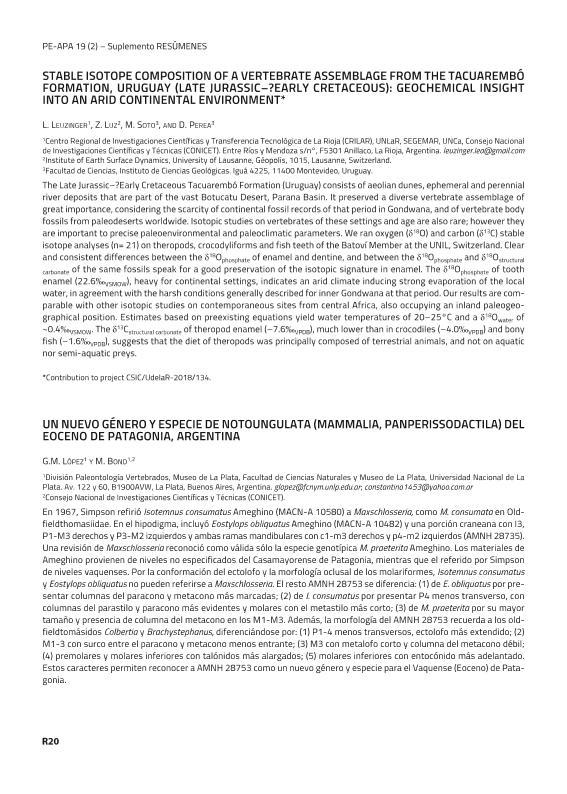Evento
Stable isotope composition of a vertebrate assemblage from the Tacuarembó Formation, Uruguay (Late Jurassic-Early Cretaceous): Geochemical insight into an arid continental environment
Tipo del evento:
Jornada
Nombre del evento:
33as Jornadas Argentinas de Paleontología de Vertebrados
Fecha del evento:
29/05/2019
Institución Organizadora:
Universidad Nacional de Córdoba. Facultad de Ciencias Exactas, Físicas y Naturales;
Universidad Nacional de Córdoba. Facultad de Ciencias Exactas, Físicas y Naturales. Museo de Paleontología;
Museo Provincial de Ciencias Naturales Dr. Arturo Umberto Illía;
Centro de Investigaciones en Ciencias de la Tierra;
Título de la revista:
Publicación electrónica de la Asociación Paleontológica Argentina
Editorial:
Asociación Paleontológica Argentina
ISSN:
2469-0228
Idioma:
Español
Clasificación temática:
Resumen
The Late Jurassic–Early Cretaceous Tacuarembó Formation (Uruguay) consists of aeolian dunes, ephemeral and perennial river deposits that are part of the vast Botucatu Desert, Parana Basin. It preserved a diverse vertebrate assemblage of great importance, considering the scarcity of continental fossil records of that period in Gondwana, and of vertebrate body fossils from paleodeserts worldwide. Isotopic studies on vertebrates of these settings and age are also rare; however they are important to precise paleoenvironmental and paleoclimatic parameters. We ran oxygen (δ18O) and carbon (δ13C) stable isotope analyses (n=21) on theropods, crocodyliforms and fish teeth of the Batoví Member at the UNIL, Switzerland. Clear and consistent differences between the δ18Ophosphate of enamel and dentine, and between the δ18Ophosphate and δ18Ostructural carbonate of the same fossils speak for a good preservation of the isotopic signature in enamel. The δ18Ophosphate of tooth enamel (22.6‰VSMOW), heavy for continental settings, 53 indicates an arid climate inducing strong evaporation of the local water, in agreement with the harsh conditions generally described for inner Gondwana at that period. Our results are comparable with other isotopic studies on contemporaneous sites from central Africa, also occupying an inland paleogeographical position. Estimates based on preexisting equations yield water temperatures of 20–25°C and a δ18Owater of ~0.4‰VSMOW. The δ13Cstructural carbonate of theropod enamel (–7.6‰VPDB), much lower than in crocodiles (–4.0‰VPDB) and bony fish (–1.6‰VPDB), suggests that the diet of theropods was principally composed of terrestrial animals, and not on aquatic nor semiaquatic preys.
Palabras clave:
Stable isotopes
,
Late Jurassic
,
Continental vertebrates
,
Fm Tacuarembó
Archivos asociados
Licencia
Identificadores
Colecciones
Eventos(CRILAR)
Eventos de CENTRO REGIONAL DE INV. CIENTIFICAS Y TRANSFERENCIA TECNOLOGICA DE ANILLACO
Eventos de CENTRO REGIONAL DE INV. CIENTIFICAS Y TRANSFERENCIA TECNOLOGICA DE ANILLACO
Citación
Stable isotope composition of a vertebrate assemblage from the Tacuarembó Formation, Uruguay (Late Jurassic-Early Cretaceous): Geochemical insight into an arid continental environment; 33as Jornadas Argentinas de Paleontología de Vertebrados; Córdoba; Argentina; 2019; 20-20
Compartir




